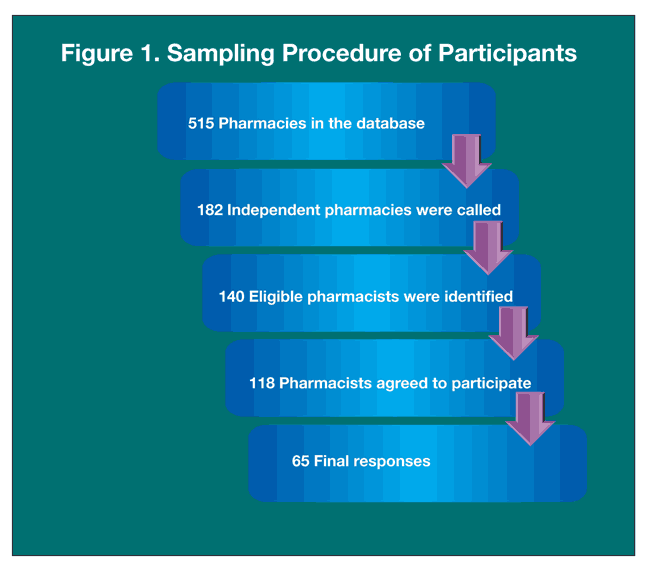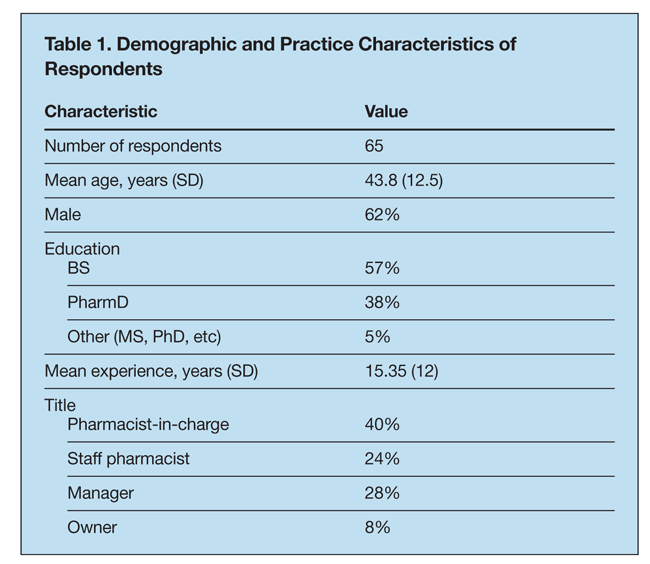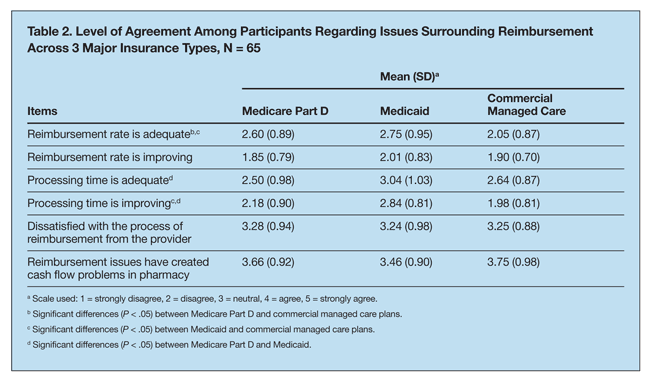- Clinical Technology
- Adult Immunization
- Hepatology
- Pediatric Immunization
- Screening
- Psychiatry
- Allergy
- Women's Health
- Cardiology
- Pediatrics
- Dermatology
- Endocrinology
- Pain Management
- Gastroenterology
- Infectious Disease
- Obesity Medicine
- Rheumatology
- Nephrology
- Neurology
- Pulmonology
Pharmacists’ Perceptions of Drug Reimbursement Rates and Processing Times Among Managed Care Plans
The effect of payment delays on the normal functioning of community pharmacy operations has been documented. We undertook a study to evaluate and compare pharmacists’ perception regarding reimbursement rates and processing time for prescription drug claims processed for Medicare Part D, Medicaid, and commercial managed care plans.
The Medicare Part D program introduced in 2006 was expected to increase business and operational processing time for pharmacies because it provided prescription drug coverage to millions of elderly beneficiaries.1 According to the US Department of Health and Human Services, 26.7 million elderly and disabled beneficiaries have prescription drug coverage, accounting for a significant proportion (approximately 27%) of the total prescriptions filled by independent pharmacies.1,2 However, soon after the introduction of Medicare Part D, several studies indicated that the plans were associated with lower reimbursement rates and delayed prescription processing time, which severely impaired the profitability and financial stability of independent pharmacies across the nation.3,4
A study by Carroll4 reported that implementation of Medicare Part D resulted in a 22% mean decrease in the profitability of independent pharmacies, primarily because of lower reimbursement rates. The National Community Pharmacists Association (NCPA), which represents independent community pharmacies, wrote in its annual report that before the implementation of the Medicare Part D program, an average of 12.4% of its pharmacies were operating at a loss, and after implementation, 22.9% operated at a loss in 2006.5
The results of a national study that analyzed Medicare Part D reimbursement processing time indicated that approximately 40% of the prescription drug claims were not reimbursed within 40 days.6 Because pharmacies are required to make payments to the wholesalers every 2 weeks, such delays were argued to be forcing independent pharmacies to take short-term loans to manage their operating expenses.5
In 2006, 1153 independent pharmacies were run out of business, which the NCPA attributed mainly to the financial instability caused by Medicare Part D reimbursement–related issues. However, the Centers for Medicare & Medicaid Services (CMS) denied the delay in claims reimbursement, stating that 18 of the top 20 Medicare Part D plans that cover more than 90% of beneficiaries reimbursed pharmacies twice monthly.7 The Pharmaceutical Care Management Association supported the CMS statement by reporting that PBMs are paying pharmacies within a 30-day period.8
In the past 3 years, there have been many discussions and arguments about reimbursement problems associated with Medicare Part D plans. A few studies have compared Medicare Part D with Medicaid payment sources9 and looked at the reimbursement disparities between chain and independent pharmacies.10,11 But to our knowledge, no study has attempted to directly evaluate and compare the magnitude of the situation across the 3 major payers: Medicare Part D, Medicaid, and commercial managed care plans.
The objective of our study was to gain a better understanding of the pharmacist’s perspective and compare reimbursement rates from these payment sources, thus providing a clearer picture of the situation. Using a survey, pharmacists were asked to compare prescription drug reimbursement rates and claim processing time in Medicare Part D, Medicaid, and commercial managed care plans.
Methods
The study used a cross-sectional survey design, and it included full-time pharmacists involved with daily reimbursement-related activities in independent community pharmacies in the Houston metropolitan area. A database of independent pharmacies in Houston was developed using the Houston Yellow Pages Web site. The sampling area was restricted to pharmacies within a 10-mile radius of the Texas Medical Center, which allowed for exhaustive sampling and eliminated any possibility of selection bias.
A pharmacy was considered to be independent if it belonged to any of these 3 categories: independent, independent franchise, or independent chain pharmacy. Mail-order, compounding, and specialty pharmacies were excluded because their dealings with prescription drugs and respective reimbursement were likely to differ.
Area-wide telephone calls were made to all selected pharmacies in the database. We verified the independent status and provided a brief overview of the survey to the eligible pharmacists using a communiqu. Pharmacists who agreed to participate were approached at a convenient time and provided with the consent form and the questionnaire. Pharmacists had the option to complete the survey and give it to a data collection assistant or fax it at a later time. Data were collected from May to August 2009 after approval from the Committee for the Protection of Human Subjects at the institution.
A questionnaire was developed and pilot-tested for validation. On the basis of the feedback during the pilot study, changes were made in the definitions and terminologies used in the questionnaire. The reimbursement rate was defined as the actual percentage of total claimed amount received from insurance payers. Reimbursement processing time was defined as the number of days taken to receive reimbursement after a claim was adjudicated.

The survey consisted of 2 sections. The first section measured pharmacists’ perceptions of the adequacy of current reimbursement rates and processing times across 3 insurance payers using a 5-point Likert scale (1 = strongly disagree, 2 = disagree, 3 = neutral, 4 = agree, 5 = strongly agree). Each pharmacist’s perception of satisfactory reimbursement rates and sufficient processing times to meet the pharmacies’ operational requirements was noted. Pharmacists were then asked whether they believed that the reimbursement rate and processing time are improving across 3 insurance payers and whether they have encountered cash flow problems because of reimbursement issues. The second section requested demographic and practice information.
A sample size of 66 was estimated to achieve a power of 80% at an effect size of 0.4 and an a level of .05 to achieve differences in rating between plans. The sampling process is provided in Figure 1.
Completed surveys were coded and entered into a database. Descriptive analyses were conducted, and the analysis of variance (ANOVA) was performed followed by Tukey multiple comparisons method to identify differences between groups. All statistical analyses were performed using SAS (version 9.2, SAS Institute Inc, Cary, NC), with an a priori significance level of 0.05.
Results
A total of 65 responses were received of 118 surveys distributed, giving a response rate of 55% (Figure 1). The demographic and practice information of the responding pharmacists is presented

in Table 1. Sixty-two percent of the participants were men, and 57% had a BS degree. The mean age of respondents was 44 years. Respondents had a mean of 15 years of practice experience, and the majority indicated their designation as pharmacist-in-charge.
In general, pharmacists’ perceptions of the reimbursement issues evaluated in this study were negative. Their scores tended to be below 3 (neutral), toward disagreement on the 5-point Likert scale (Table 2). They disagreed that reimbursement rate and processing time were adequate. They also did not believe that the reimbursement rate and processing time have improved. Further, they agreed that they were dissatisfied with the process of reimbursement and that it had created cash flow problems for their pharmacy.
The results of 1-way ANOVA and subsequent Tukey multiple comparisons analysis indicated some interesting results (Table 2). Although the reimbursement rate was perceived as inadequate, scores were significantly lower for commercial managed care plans than for Medicare Part D and Medicaid (F2,63 = 10.9; P < .001). Pharmacists indicated lower scores with respect to improvement in the reimbursement rate, and the scores did not differ significantly between the 3 payers. On the question of adequate processing time, Medicaid was perceived to be better than Medicare Part D and commercial managed care plans (F2,63 = 5.42; P < .01). Although scores were lower, Medicaid

differed significantly from Medicare Part D and commercial managed care plans with respect to improvement in processing time (F2,63 = 18.5; P < .0001). Dissatisfaction with the process of reimbursement was high and consistent across all 3 payer groups. Similarly, they agreed that they had cash flow problems consequent to the lack of adequate reimbursement rates and processing times, and this was consistent across all three payers as well.
Discussion
This study explored and compared perception of pharmacists regarding reimbursement-related issues across 3 major payment sources: Medicare part D, Medicaid, and commercial managed care plans. The findings indicate that pharmacists’ perception in general is consistent with previous studies and reports by the NCPA. However, there were some additional findings that were not reported before and that were identified in this study. Pharmacists, in general, believed that reimbursement rates were inadequate and processing time was longer for all 3 payment sources. However, they perceived that reimbursement rates from government-run programs-Medicaid, followed by Medicare Part D programs-were better than commercial managed care plans.
Our results were in accordance with a previous study that showed that Medicare Part D plans had low reimbursement rates.4 In our study, however, we found that the Medicare Part D reimbursement rates were believed to be slightly better than commercial managed care plans. The reimbursement processing time was believed to be better in Medicaid than in Medicare Part D, but it did not differ significantly between Medicare Part D and the commercial managed care plans. Most likely, this is because pharmacies receive direct payments from the state agencies for Medicaid claims, whereas for Medicare Part D and commercial managed care claims, they are generally reimbursed by PBMs.12 In previous reports, PBMs have often been criticized for their vested interests in delaying payments.13 This trend was perceived in our study as well.
The findings indicate that pharmacists did not believe reimbursement rates and processing times are improving across the 3 insurance payers. Despite this general perception of a lack of improvement, Medicaid reimbursement rates and processing times were perceived to be better than Medicare Part D and commercial managed care plans. This finding was consistent across all issues measured and points toward relatively greater satisfaction among pharmacists with Medicaid than with the other 2 payers.
Pharmacists reported that they were dissatisfied with the process of reimbursement, in general, and believed that they do face cash flow problems, but they attributed this to all 3 insurance payers. These results are inconsistent with the post-implementation surveys of independent pharmacists by Redford and colleagues10 and the Kaiser Family Foundation,11 wherein pharmacists reported Medicare Part D to be the major source of financial troubles.
In this study, Medicare Part D was believed to be either superior to or at par with the commercial managed care plans, which suggests the need for future research comparing Medicare Part D directly with commercial managed care plans utilizing claims databases. A comparison between these 2 insurance payers would be more justifiable given the aforementioned fact that plans under both of these are generally reimbursed by an intermediate, the PBMs, unlike Medicaid plans, which are directly reimbursed by the state agencies.
It would be interesting to see how health care reform may affect these reimbursement-related issues. Will the new policies alleviate the claimed financial burden on pharmacies or aggravate the existing situation?
The difference in pharmacists’ perception found in our study among the 3 payers can be attributed to a few plausible reasons. First, previous studies did not directly compare the payers and, hence, did not measure the relative magnitude of differences between the payers. Second and most likely, experiences in processing time are real and are remembered, especially when they are negative.
The findings of this study should be interpreted in the context of certain limitations. Although, participants surveyed represent a diverse group of independent pharmacies, the pharmacists in this study may not represent the perceptions of pharmacists nationwide. Pharmacists who did not participate in the study may differ from those who participated, but a nonrespondent bias analysis could not be performed because of the unavailability of data.
We did not evaluate reimbursement rates and processing times within different plans under each of the 3 major insurance payers. In addition, factors such as total number of prescriptions processed (thus experiences) within each payer category were not identified and controlled. This study was based on pharmacists’ general perceptions of the issues under study. We believed that their perceptions are developed through real experiences while dealing with reimbursement issues in their day-to-day practice and would reflect the actual situation of existing issues. Furthermore, selection of only pharmacists dealing with daily reimbursement activities allowed reducing and controlling for the likely information bias. However, further research may be needed to validate these findings using other measures, such as claims databases to provide a better picture of the situation.
References:
References
1. National Community Pharmacists Association. NCPA-Pfizer Digest preliminary data shows independent community pharmacies have been hurt by Medicare Part D prescription drug plan. Alexandria, VA: National Community Pharmacists Association; June 13, 2007.
2. Kaiser Family Foundation. The Medicare prescription drug benefit fact sheet. November 2009. http://www.kff.org/medicare/upload/ 7044-10.pdf. Accessed November 11, 2009.
3. Spooner JJ. A bleak future for independent community pharmacy under Medicare Part D. J Manag Care Pharm. 2008;14:878-881.
4. Carroll NV. Estimating the impact of Medicare part D on the profitability of independent community pharmacies. J Manag Care Pharm. 2008;14:768-779.
5. National Community Pharmacists Association. NCPA-Pfizer Digest 2008. Alexandria, VA: National Community Pharmacists Association; 2008.
6. Shepherd MD, Richards KM, Winegar AL. Prescription drug payment times by Medicare Part D plans: results of a national study. J Am Pharm Assoc. 2007;47:e20âe26.
7. Norwalk L. Centers for Medicare & Medicaid Services. Pharmacists and Part D. May 23, 2006. http://www.cms.hhs.gov/apps/media/press/testimony.asp?Counter=1864. Accessed November 11, 2009.
8. Pharmaceutical Care Management Association. PCMA: PBMs paying clean claims within 30- day timeframe. June 13, 2007. http://www.pcmanet.org/pcma-pbms-paying-clean-claims-within-30-day-timeframe. Accessed November 11, 2009.
9. Department of Health and Human Services. Office of Inspector General. Comparing Pharmacy Reimbursement: Medicare Part D to Medicaid. February 2009. http://oig.hhs.gov/oei/ reports/oei-03-07-00350.pdf. Accessed November 11, 2009.
10. Redford A, Slifkin R, Fraser R, et al. The experience of sole community rural independent pharmacies with Medicare Part D: reports from the field. November 2006. http://www.shepscenter.unc.edu/research_programs/rural_program/pubs/report/WP87.pdf. Accessed November 14, 2009.
11. Kaiser Family Foundation. National survey of pharmacists and national survey of physicians: findings on Medicare Part D. September 2006. http://www.kff.org/kaiserpolls/upload/7556.pdf. Accessed November 14, 2009.
12. Frank RG, Newhouse JP. Should drug prices be negotiated under part D of Medicare? And if so, how? Health Aff (Millwood). 2008;27:33-43.
13. Association of Community Pharmacists Congressional Network. Pharmacy benefit managers’ (PBMs) tactics prevent real savings in Medicare drug plan. May 2006. http://www.acpcn.org/articles/PBM%20Tactics%20Prevent%20Medicare%20Savings-May%2015.pdf. Accessed March 30, 2010.
